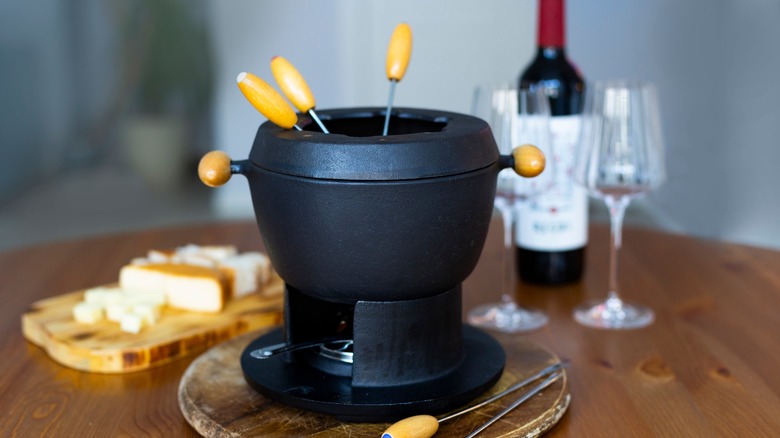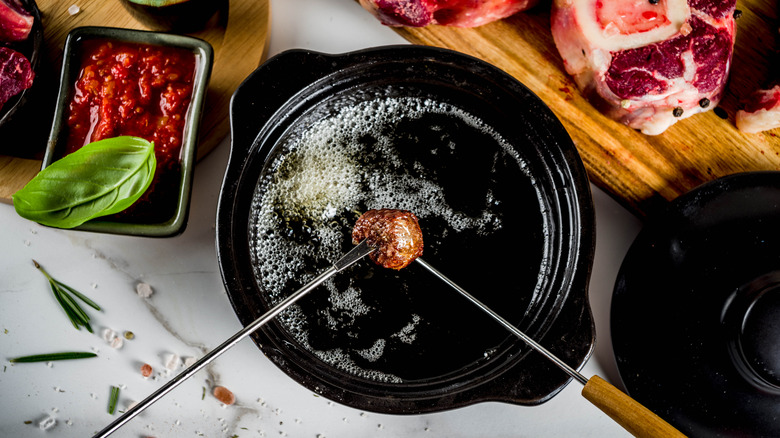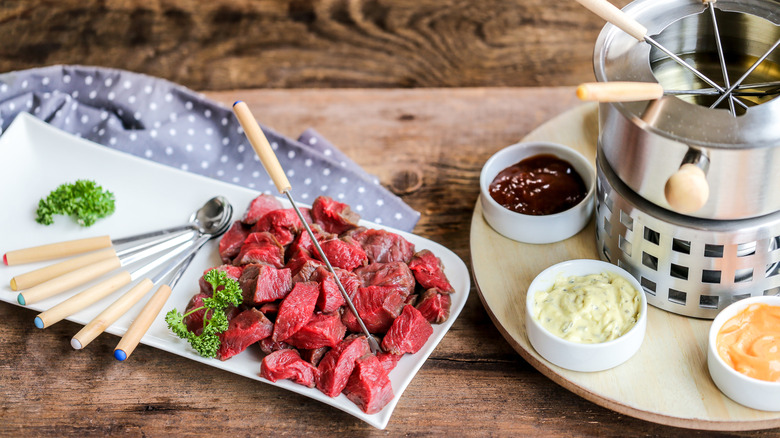Change Up Fondue Night With Your Favorite Meats And A Pot Of Oil
A fun event for entertaining guests at home, fondue parties first gained popularity in the 1960s. With a few assembled items, home cooks discovered the ease of producing not only a satisfying meal, but an interactive dining affair for family and friends to participate in. The origins of dipping ingredients in hot oil began much more simply, however, with Swiss field workers using the setup as a convenient way to eat a good meal without needing to trek back home for lunch.
If you're not a fan of dipping ingredients into warm pots of cheese or chocolate, oil provides a delicious alternative. Oil can similarly be heated up in pots and used to cook meat and vegetables. While many different cooking oils can be used for fondue, the type of oil you choose will impact the taste of your meal.
Regardless of whether you're dipping cuts of beef or bread, the oil in the fondue pot will need to be hot, just like melted cheese or chocolate. Fondue pots do require some sort of heat source to keep the dipping ingredient warm, but once you have your set up ready to go, you'll simply have to provide the ingredients and let guests help themselves.
Fondue tips to keep in mind
Swiss-based presentations often serve cubed pieces of raw beef tenderloin to dip into the hot pot of oil, and an assortment of condiments are served on the side to add flavor and texture to the cooked pieces. Mayo, mustard, and salsa are a few of the accompaniments you might find. Yet in France, you may find pots of olive oil seasoned with garlic and pepper or boiling fondue of spiced red or white wine used to cook meats.
Regardless of the style you choose, pick an oil with a higher smoke point since heating up fondue pots requires high temperatures. Oils with lower smoke points can burn and impact the overall taste of each ingredient. Canola, vegetable, and peanut oil have higher smoke points and offer a solid base for cooking ingredients. Take a temperature read before you start cooking meat — the oil should be around 375 degrees Fahrenheit — and add lemon juice or white wine vinegar to the pot so that your oil is at less risk of burning.
Instruct guests to allow plenty of room in the pots for the meat to cook properly; placing too many skewers into the pot at once can result in uneven cooking. In one to three minutes (depending on the heat of the oil), you can cook meat to your preferred level of doneness and enjoy a warm, flavorful meal.
Creating your own fondue experience
Cuts of meat best for oil-based fondue can be cooked to medium rare when placed into oil that has reached 130 to 140 degrees Fahrenheit. Sirloin is tender, buffalo offers a gamier meat, filet mignon may be a bit more pricey but offers a buttery treat, and flank steak offers a lean cut that can be easily seasoned. And because some diners prefer chicken over steak, it's also a good idea to offer an assortment of meats for your guests and cut the pieces into half-inch cubes or longer strips for easy cooking.
Though you don't need to season raw meat before placing it into fondue pots, providing an assortment of spices and dried herbs for guests to season their own cuts of meat can provide an additional interactive element to your fondue party. Seasoning mixes, rubs, dried herbs, sauces, and dips can all be added to fondue pots for extra flavor.
After you've selected the meats you'll offer your guests, choose the vegetables that can accompany these proteins. Set similarly cut vegetables like potatoes, mushrooms, green beans, and zucchini that can be speared by skewers and cooked alongside pieces of meat. If you'd like to prepare steamed or baked vegetables or side salads in advance to offer alongside the meat fondue, you can place the pre-made dishes out for guests to help themselves. Additionally, setting out dishes filled with soy and Worcestershire sauces, balsamic vinegar, or crunchy chili sauce can add to the flavor of the meats and let the attendees customize their plates.


